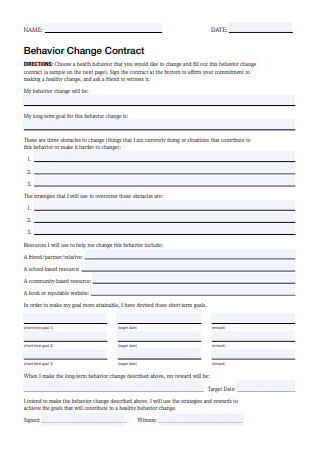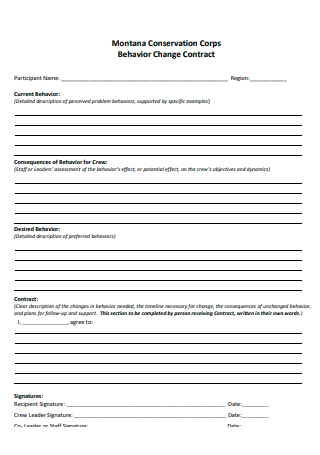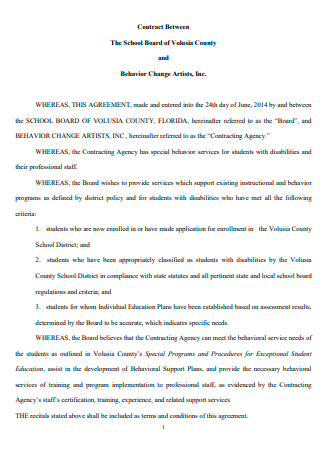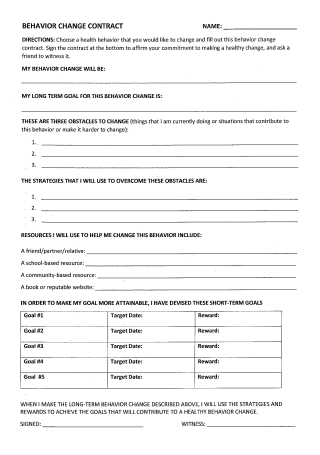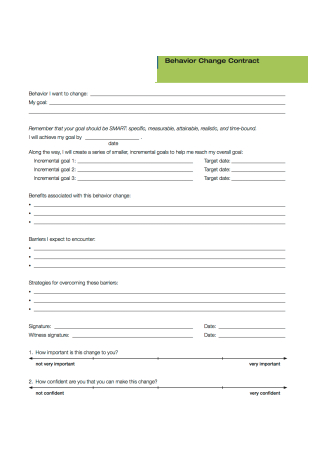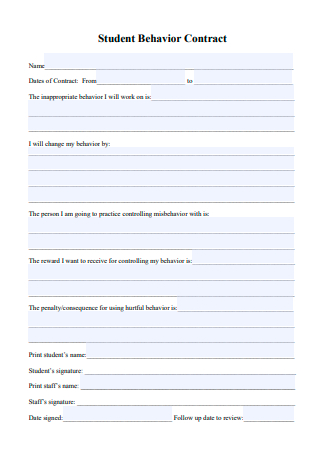5+ Sample Behavior Change Contract
FREE Behavior Change Contract s to Download
5+ Sample Behavior Change Contract
a Behavior Contract?
Benefits of Behavioral Change Contracts
Stages of Behavioral Change
Tips in Doing a Healthy Behavioral Change
How To Create a Behavior Change Contract
FAQs
What information should a behavior contract contain?
What is an ABA behavioral contract?
How can I create a plan for behavior modification?
What Is a Behavior Contract?
A behavior contract between your child and their teacher frequently includes you. The agreement details your child’s behavioral expectations. It details any specific behaviors that your child suffers or is working on. Ideally, the objectives will be reachable while remaining hard. Also, it describes the benefits and penalties associated with meeting or failing to accomplish goals. Contracts governing behavior can take a variety of forms. They may take the shape of official agreements or sticker charts. There is no superior form. What matters is that the contract is beneficial to your child. Each year, nearly 1.2 million kids in the United States alone drop out of high school. This equates to one pupil every 26 seconds – or 7,000 students every day. Around 25% of first-year high school students do not graduate on time.
Benefits of Behavioral Change Contracts
For various reasons, a behavioral change contract can be a successful strategy. Several of the advantages include the following:
Stages of Behavioral Change
According to the transtheoretical change model, behavior change occurs in six stages.
Tips in Doing a Healthy Behavioral Change
How many of us have set a health-related New Year’s resolution and only followed through on it for the first few weeks of January, if at all? Resolving to change is far easier than actually changing and staying with it long term, whether to lose weight or exercise more. Do you want to make a long-term healthy behavior change? Follow the advice in the following sections, which is based on social science research and health behavior theory.
-
1. Concentrate on a single behavior modification objective at a time.
It’s challenging to change one’s lifestyle or habit for the long term, let alone many times. Changing a behavior, whether it’s stopping smoking, going to bed earlier, or beginning a new workout regimen, is a multi-step process that takes thought, action, and maintenance. You may be tempted to change numerous health-related activities at once, but attempting to change too many things may overwhelm you and cause you to revert to old habits and behaviors quickly. Trying to modify too many conducts at once, particularly “cold turkey” on unhealthy habits, might result in tiredness and “cheating” on your goals. Concentrate on a single tiny or manageable change at a time. Once you’ve established a new habit, you can go on to your next objective.
2. Choose a behavior over which you have complete control.
While you may desire or require less stress in your life for health reasons, the occurrence of stressful situations may be beyond your control. You may lack control over a work setting that requires many hours spent in front of a computer. You may feel that you have no power over whether friends, roommates, or family members bring unhealthy meals into the house or what a family member cooks for breakfast without your permission. Social standards may compel you to avoid “fussing” over these matters. Additionally, you can urge friends, family members, and coworkers to support your healthy behavior changes by not encouraging problem behaviors or looking at you oddly when you ask a coworker to accompany you on a walk for a one-on-one meeting.
3. Determine why you want to start a healthy habit.
Our motivations play a significant role in determining how we behave. Without a strong personal incentive to support the desired change in health behavior, we may consider but never implement the change. According to Social Cognitive Theory, a variety of unique and environmental factors influence our behavior, including our belief, the outcomes we anticipate if we engage in the behavior, the knowledge and skills we possess or require to engage in the behavior, and the rewards or punishments encountered along the way.
4. Conduct research.
Knowledge is a crucial predictor, or at the very least a forerunner, of change in practically every theory of health behavior. If you’re thinking of ending an unhealthy habit or starting a new healthy one, learn everything you can from reliable sources. What are the proven advantages or disadvantages of this conduct for persons like you? Learning more about the unique benefits for you of a generally considered healthy practice, such as exercise and appropriate sleep, might help you become more motivated to adopt and maintain this behavior over time.
5. Give it time.
Five stages of transformation have been identified in health behavior research. The first stage is pre-contemplation, during which you become aware of problem behavior and seek knowledge about its negative consequences and possible solutions, such as stress management. Following that, you’ll consider change and be ready to implement the new health behavior. Following reflection, which a conversation may inspire with your doctor or advice from a friend or family member, you’ll proceed to preparation and then action. If you maintain your new behavior, the final phase is maintenance. This process typically takes many months, if not longer. Therefore, be patient and allow yourself time! You may spend months thinking and planning for a health behavior change before eventually taking action – the goal is to avoid becoming locked in a phase.
6. Solicit assistance.
We can bring a particular health behavior under our perceived control by seeking assistance, increasing our chances of long-term success. It’s much easier to keep to a low-carb diet if you inform your family and friends, so they can stop bringing you cookies for the holidays and take your diet into account while cooking or collectively deciding on a restaurant location. Soliciting assistance or seeking support from family, friends, and coworkers can mean the difference between success and failure with your new health behavior goal. It may be challenging to effect change on your own. Even the most tenacious among us will succumb and eat the cookie on the third, fifth, or tenth occasion.
How To Create a Behavior Change Contract
Every teacher has at least one difficult student in her class, a youngster that needs additional structure and motivation to overcome negative behavior patterns. These are not always horrible children; they frequently require additional support, design, and discipline. Contracts with these students can assist you in molding their conduct so that they no longer disturb learning in your classroom. If you’re still interested, here are some measures to take before establishing one.
-
1. Customize the Agreement
To begin, create a change strategy. Utilize this behavior contract as a basis for your upcoming conversation with the student and their parents. Customize the form to your specific situation, considering the child’s personality and preferences.
2. Arrange A Meeting
Following that, convene a meeting appointment with all parties involved. If your school has an assistant principal in charge of discipline, invite them to the forum. Both the student and their parents should present. Concentrate on one or two specific behaviors that you wish to modify. Attempt not to make drastic changes all at once. Take small steps toward significant development and establish goals that the student believes are attainable. Demonstrate your concern for this child and your want to see them succeed in school this year. Remind parents, students, and teachers that they are all on the same team.
3. Inform the Public of the Consequences
Define the tracking method that will be utilized to monitor student conduct daily. Describe the incentives and repercussions associated with specific behaviors. Be very explicit and brief in this section, and whenever possible, offer quantitative explanations. Include parents in the process of developing a system of incentives and penalties. Ascertain that the consequences chosen are significant to this youngster; you can even ask for a feedback report from the child to increase their buy-in. Sign the agreement with all parties involved and conclude the meeting positively.
4. Arrange for a Follow-Up Meeting
2–6 weeks after your initial meeting, schedule a follow-up meeting to discuss progress and make any necessary revisions to the plan. Inform the child that the group will reconvene shortly to discuss their progress. Additionally, exercise patience. Never abandon this youngster. Misbehaving children frequently want additional love and positive attention, and your investment in their well-being can go a long way.
5. Keep a Consistent Attitude in the Classroom
Meanwhile, maintain a high consistency with this child in the classroom. As much as possible, adhere to the language of the behavior contract agreement. Praise the child when they make appropriate behavior choices. When the child causes terrible decisions, do not apologize; if necessary, get out the contract and go over the terms and conditions agreed upon by the youngster. Make a point to emphasize the positive consequences of good behavior and enforce any adverse penalties in the contract for the child’s bad behavior.
FAQs
What information should a behavior contract contain?
A behavior contract is a contract between your child and their instructor. It frequently includes you as well. The contract spells out your child’s behavioral expectations. It outlines any specific behaviors that your child issues with or is working on and the behaviors’ goals.
What is an ABA behavioral contract?
Alternatively referred to as a contingency contract, the behavior contract is signed by the contingency manager and the individual whose behavior is modified. The agreement describes the desired behavior that must be accomplished and how the individual will be rewarded for successfully performing it.
How can I create a plan for behavior modification?
Your behavior modification strategy should incorporate reinforcers, consequences that encourage desired conduct, punishers, or effects that discourage undesirable behavior. The best technique is to use natural or logical products, depending on the type of behavior adjustment your child requires.
Are you planning or preparing to begin the process of developing a comprehensive behavior change contract? Please refer to our downloadable template examples and the discussion of this post for additional information. It is preferable to be directed throughout creating the specified document. This will assure the quality of the behavior modification contract that will serve as your output. Choose a template and begin developing your behavior change contract.

